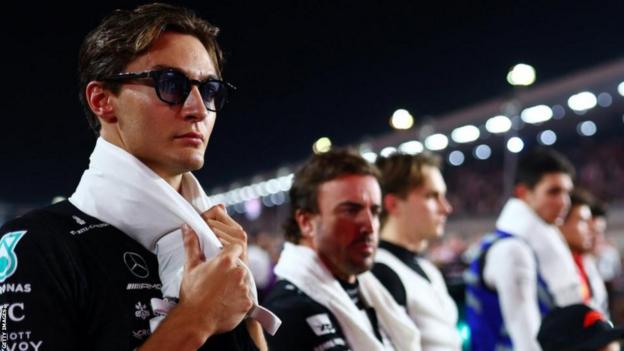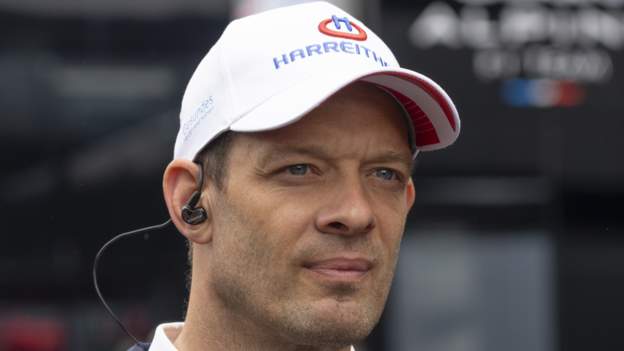
The head of Formula 1’s drivers’ organisation says the Qatar Grand Prix proved that there is a heat-related limit for the human body in the sport.
Several drivers needed medical attention after the race for either dehydration or heat exhaustion.
Meanwhile, Alpine’s Esteban Ocon vomited in his helmet.
Grand Prix Drivers’ Association chairman Alex Wurz said F1 must look into what needs to be done to address the issue.
“It’s too easy to say: ‘Here is a gym membership – get on with it,'” he said.
Wurz, speaking exclusively to BBC Sport, added: “There are multiple contributing factors which need to be understood by everyone.”
He said a first step should be a study of heat effect across motorsport, and that other categories had already introduced technologies to regulate temperature, such as the cooling of drivers’ seats.
Wurz said: “My initial thoughts revolve around lessons from other categories which have shown heat as a limiting factor for drivers.
“Cooling seats, for example, work very well and are not too difficult to produce and install. That is something every team should already be looking at.
“There needs to be better insulation and/or air cooling for very hot electrical boxes, which are often sited near the drivers’ seat, or in the future reroute hot hydraulic lines, so the driver’s seat environment is not overheating.
“The entire rules set has tests and limits for many parts of the car. Given the driver is one of the performance parts of the equation, perhaps it is time to look at defining limits to the heat they are subjected to.”
Governing body the FIA said on Monday that it was launching its own inquiry into the events of Qatar, where conditions were described as “beyond the limit” by Mercedes’ George Russell and “too extreme” by world champion Max Verstappen.
Williams driver Logan Sargeant had to retire from the race with intense dehydration worsened by earlier flu-like symptoms.
His team-mate Alex Albon was taken to the medical centre for treatment for acute heat exposure. Other drivers also sought out medical attention for dehydration and heat.
Wurz said this was not the first time conditions had pushed drivers to the limit, and admitted that it was part of the sport.
But he said the way F1 responded rapidly to safety issues with Pirelli tyres in Qatar was an example of the fact changes can be made quickly when necessary.
What could be done?
Wurz, a former F1 driver who has also won Le Mans twice, said it would be wrong to characterise the problem as one of fitness.
F1 drivers are already extremely fit. The issues in Qatar were do with the body’s ability to deal with extreme heat and humidity for long periods while also coping with heavy physical exertion and high G-loadings.
Fitness does not necessarily correlate with resistance to heat effect, he said, but heat fatigue had to be taken seriously and needed deeper understanding – not to make F1 “easy” but to ensure the environment for the driver does not become unsafe or unreasonable.
Wurz added that he had his own experience of one of the contributing factors to the problem in his role as adviser to the Toyota world endurance championship team.
He said new fireproof materials introduced into racesuits following Roman Grosjean’s fiery crash in the 2020 Bahrain Grand Prix were causing heat fatigue because they offered reduced breathability.
Wurz said: “They cook you. I recently tested a car while wearing the new mandatory fireproofs, and I was shocked how hot I was.
“Of course those fireproofs are here for a very good reason and I am not suggesting a return to lower fireproofing standards, but for those who are not aware what is happening, that is one of many contributing factors.”
A number of factors combined in Qatar to exacerbate the problem, including the imposition of mandatory tyre-life limits because of safety problems with the tyres.
Ferrari’s Charles Leclerc said: “First, it was probably the hottest race we have had since I was in F1. Second, the high-speed corners of this track. And third is that we had three [pit] stops, so no tyre management, so qualifying lap after qualifying lap for 57 laps.”
Wurz, who was in Qatar, added: “The asphalt, once clean of dust, proved to be very high-grip and the race was not about managing the thermal tyre degradation as much as usual, in itself a very interesting fact.
“But for the heat debate this is a further important aspect, as this means that race lap times and driving style were pushing more every lap and generating more forces and stress.”
It is not the first time drivers have suffered in hot and humid conditions, but when drivers had tyres on which they could always push to the limit in the era of Michelin and Bridgestone from 1998-2010, the cars were lighter and had less downforce.
Wurz said: “I had heat issues in race cars myself, and at times some of my colleagues and I believe that in the old days it was harder.
“Yes, perhaps it was hard, but in this case I really don’t think it was ever as hard as this Doha race.
“I can guarantee you that the drivers are hard-fighting guys and after this race the scene was far from pretty.
“It made it clear to me that this topic must be followed up to establish whether the mitigation needs to be in the hands of teams only, or requires rules to be amended and/or formed.
“And seeing some of the debates around this, let’s have cool heads prevailing and go about it systematically.”
